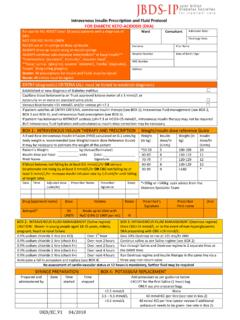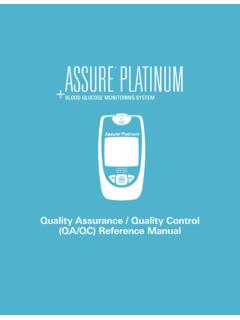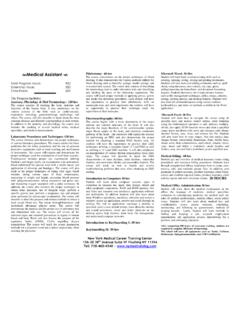Transcription of The care children with Type 1 diabetes need in school
1 The care children with Type 1 diabetes need in schoolGive this booklet to your schoolBy supporting a child with Type 1 diabetes at your school , you ll be making a big if diabetes isn t managed properly it can lead to serious problems in the in the short-term if a child is struggling with their diabetes in school , it s likely they ll struggle in the classroom too. If it s not well managed, Type 1 diabetes can mean a child has difficulties with attention, memory, processing speed, planning, organising, and perceptual you ve got more questions after you ve read this booklet then we have plenty of other ways we can help help can be found at call or email our Helpline. You can find details on the back of this to use this handbookWe ve created this handbook to help you get to grips with providing the right care for children with diabetes at your school . Please keep it to hand so you can refer to it when you need to.
2 The handbook has been divided into sections so you can find the relevant information quickly and a read through the book in full at first so you re familiar with the are some key terms that you ll need to get familiar with when caring for a child with Type 1 diabetes . We ve included some of the main ones below, which are mentioned throughout this handbook:PDSN Paediatric diabetes Specialist NurseIHP Individual healthcare planMDI Multiple daily injectionsCGM Continuous glucose monitorHypo Short for Hypoglycaemia and means low blood sugar (also known as blood glucose ) levelsHyper Short for Hyperglycaemia and means high blood sugar levels3 No child with Type 1 diabetes should be excluded from any part of the school curriculum. Every child with Type 1 diabetes should have access to extracurricular activities, including overnight stays and trips abroad. Schools, local authorities and health services should work together to make sure they meet the needs of children with Type 1 diabetes .
3 Paediatric diabetes teams should provide training and support to schools, so school staff have the skills and confidence they need to look after a child with Type 1 diabetes . No parent should be relied on to go into school to treat their child s diabetes . Every child with Type 1 diabetes should be allowed to inject insulin, in public or in private, depending on their wishes. Every school should have a medical conditions at school policy, which is updated every year. Every child with Type 1 diabetes should have an individual healthcare plan (IHP), which details exactly what their needs are and who will help them. Parents should provide up-to-date information about their child s needs and all the supplies needed to manage diabetes in child with Type 1 diabetes deserves to have the same education as their classmates. This means:What care to expect at school4 Don t assume that all children with Type 1 diabetes have the same school staff should know what to do in case of emergency and at least two people should be trained in how to care for a child with Type 1 diabetes .
4 Planned staff absences should be co-ordinated so that there is always one trained person in school . Schools and parents should agree on a clear method of communication. children with Type 1 diabetes should never be left alone when having a hypo or be prevented from eating or drinking to prevent or treat a hypo. children with Type 1 diabetes should never be prevented from blood testing or taking insulin and should be able to look after their equipment themselves. When children with Type 1 diabetes have exams, specific plans should be included in that year s individual healthcare plan and agreed between the school , the child and their parents. children with Type 1 diabetes should not be sent home frequently or penalised for poor attendance when absence is related to their diabetes . Every child with Type 1 diabetes should be listened to and their views taken into startedTo start with you ll need to know a little bit more about Type 1 diabetes and the sorts of things that need to be in place at your startedTo look after a child with diabetes properly your school needs: a medical conditions policy an individual healthcare plan (IHP) for each child appropriate training for staff a working relationship between the child, their parent or carer and their Paediatric diabetes Specialist Nurse (PDSN).
5 What is Type 1 diabetes ?Type 1 diabetes develops when your pancreas can t make any insulin to manage the levels of glucose in your blood properly, allowing too much glucose to build need insulin to help glucose get into our body s cells, where it s used for energy. If glucose can t get into the cells and your blood sugar levels are too high for too long, you can get extremely 1 diabetes usually develops before you re 40 years old, and is the most common type of diabetes found in children and young people. It s one of the main types of diabetes . The other is Type 2 diabetes . They re different conditions, but once you re diagnosed with either, you have it for the rest of your information in this handbook is about children with Type 1 with Type 1 diabetes are just like other children . But because they need to inject or pump insulin, test their blood and manage hypos, they can sometimes feel different from their friends and many children don t want to stand out or be treated differently, there may be times when they need extra help and support.
6 So talking about their diabetes should always be done s important to remember that children with Type 1 diabetes are not all the same. The way one child manages their diabetes will be different to another. So you, or whoever is responsible for caring for a child with diabetes at your school , will need specific advice and training in their individual needs from their parent and child with Type 1 diabetes should have an individual healthcare plan, which should be developed following a meeting with the child (where appropriate), their parent or carer, PDSN and relevant school staff. This plan should detail the child s individual care download a sample individual healthcare plan go to The 4Ts of Type 1 diabetesAs you work in a school , you can be in a position to spot the early signs that a child may have Type 1 diabetes . There are four common symptoms you can look out for.
7 We call them the 4Ts of Type 1 diabetes :If a child is going to the toilet a lot, has increased thirst which they can t quench, is more tired than usual or is losing weight it could be a sign they have Type 1 diabetes . Don t delay tell the parents or carer and advise them to take their child to a doctor immediately for a test. Undiagnosed Type 1 diabetes can be your child is experiencing any of the 4Ts, visit your doctor immediately for a test. Don t delay. Type 1 diabetes can be the 4Ts of Type 1 diabetesIt could save a child s lifeThe 4Ts diabetes UK 2017 1113A 9890 EINT/061711 Taking insulin and checking blood sugar levelsChildren with Type 1 diabetes can t produce any insulin. This means they must take insulin and check their blood sugar levels regularly throughout the insulin and checking bloodsInsulin Insulin can t be swallowed like a medicine. A child will either need to inject insulin or deliver it via a insulinChildren who need to inject at school will need to bring in their insulin and injecting equipment.
8 In most cases the equipment will be an insulin pen device rather than a syringe. Some children may want a private area where they can take their injections, others may be happy to inject in public. Both situations should be allowed. children might need help with injecting, especially if they re younger, newly diagnosed or have learning difficulties. Their parent, carer or PDSN will be able to explain the help they need, demonstrate how the equipment is used and tell you how the pen and insulin should be daily injectionsIf a child injects insulin then they ll usually take four or more injections a day. This is known as multiple daily injections or children are now started on MDI from diagnosis. children taking MDI will need an injection with each meal as well as one at bedtime and possibly in the morning. This means they ll need to have an injection at lunchtime, and perhaps at other times of the school day insulin and checking bloodsTwo injections a dayWhile it s a lot less common now, some children have two injections a day.
9 They ll usually take them at breakfast and evening meal time, and so won t usually need to inject during the school day. Insulin pumpsAn insulin pump delivers a small amount of insulin round the clock via a tiny cannula, which sits just under the skin. The cannula usually stays in place for 2 3 days so shouldn t need changing at school unless it becomes dislodged or blocked. Insulin pumps at schoolChildren who use an insulin pump will need to deliver extra insulin via the pump when they eat or if their blood sugar levels are high. This is done by pressing a combination of buttons. Again, children might need help with this. Their parent, carer or PDSN can teach school staff how to give insulin via the pump and how to look after the pump at sugar checkingMost children with diabetes will need to check their blood sugar levels on a regular basis, including at blood sugar levels involves pricking the finger using a special device to obtain a small drop of blood.
10 This is then placed on a testing strip, which is read by a small, electronic blood sugar meter. A test usually takes a few child is likely to need to test: before meals before, during and after physical activity if they re unwell anytime they or school staff feel that their blood glucose level is too low or too might need help with checking their blood, especially if they re younger, newly diagnosed or have learning difficulties. Their parent, carer or PDSN will be able to explain the help they need, how the equipment is used and how often testing should be glucose monitor (CGM)Some children will wear a CGM. This is a small sensor that remains attached to them 24 hours a day, and gives automatic and frequent blood sugar readings. children wearing a CGM generally won t need to prick their finger to check their blood sugar levels during school hours. Often a CGM will have an alarm to alert people if their blood sugar levels go too low or too help a child needs with taking insulin and blood sugar monitoring will be explained in their individual healthcare glucose monitorsSome children might check their blood sugar levels with a flash glucose monitor.















